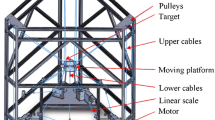Abstract
Considering the distinctive structural features and complex construction aspects of the five-hundred-meter aperture spherical radio telescope (FAST), this paper proposes the accumulative traction of serial cable construction technology (ATSC). This method makes full use of the guiding function and load-bearing capacity of guide ropes, which are simple and inexpensive, and the setting of catwalks is avoided. The entire ATSC process is divided into several static cases, and the NDFEM form-finding method is introduced to obtain the structural response of each case. Based on the principle of the constant total unstressed length of guide-rope elements, two strategies and a varying multiplication coefficient, λ, are introduced, and the “element length recursive multiplication” strategy is found to excel in terms of the analysis efficiency. Additionally, the total unstressed length of the guide-rope elements is set to three different values to determine the configuration trends. The results show that the most unfavorable configuration of guide ropes exists in initial cases and that the optimal unstressed length of the guide rope lies at an intermediate value between the total unstressed length of the serial main cables and the straight-line distance between the two endpoints of the guide rope for FAST.
Similar content being viewed by others
References
Barnes, M. R. (1999). “Form finding and analysis of tension structures by dynamic relaxation.” International Journal of Space Structures, Vol. 14, No. 2, pp. 89–104, DOI: 10.1260/0266351991494722.
Chen, W. J., Zhou, J. Y., and Zhao, J. Z. (2014). “Computational methods for the zero-stress state and the pre-stress state of tensile cable-net structures.” Journal of Zhejiang University SCIENCE A, Vol. 15, No. 10, pp. 813–828, DOI: 10.1631/jzus.A1400080.
Ding, M. M., Luo, B., Guo, Z. X., and Pan, J. (2015). “Integral towlifting construction technology of a tensile beam-cable dome.” Journal of Zhejiang University SCIENCE A, Vol. 16, No. 12, pp. 935–950, DOI: 10.1631/jzus.A1500189.
Dong, S. L. and Luo, Y. Z. (2002). “Nonlinear force method analysis for space truss with mobile mechanisms.” Acta Mechanica Solida Sinica, Vol. 23, No. 3, pp. 288–294, DOI: 10.3969/j.issn.0254-7805.2002.03.005.
Fan, F., Li, Y. G., Qian, H. L., and Zhu, E. C. (2015). “Seismic responses of the supporting structure of FAST under multiple-support excitations.” Advances in Structural Engineering, Vol. 18, No. 5, pp. 675–685, DOI: 10.1260/1369-4332.18.5.675.
Li, D., Nan, R., and Pan, Z. (2012). “The Five-hundred-meter Aperture Spherical radio Telescope project and its early science opportunities.” Proc. of the Int. Astronomical Union: Neutron Stars and Pulsars: Challenges and Opportunities after 80 Years, Cambridge University Press, Beijing, China, Vol. 8, No. S291, pp. 325–330.
Liu, Y. and Gao, F. (2015). “Study on the working state of the five hundred-meter aperture spherical telescope using step-wise assignment method.” Proceeding of the Institution of Mechanical Engineers, Part C: Journal of Mechanical Engineering Science, Vol. 229, No. 2, pp. 316–324, DOI: 10.1177/0954406214533528.
Luo, B., Guo, Z., and Wang, Y. (2010). “Cable polygon model based on initial equilibrium state.” Journal of Building Structures, Vol. 11, No. 31, pp. 72–77, DOI: 10.14006/j.jzjgxb.2010.11.010. (in Chinese)
Luo, B., Guo, Z., Chen, X., Gao, F. and Wang, K. (2015). “Static equilibrium form-finding analysis of cable-strut system based on nonlinear dynamic finite element method.” Advanced Steel Construction, Vol. 11, No. 4, pp. 452–468, DOI: 10.18057/IJASC.2015.11.4.4.
Meguro, A., Shintate, K., Usui, M., and Tsujihata, A. (2009). “In-orbit deployment characteristics of large deployable antenna reflector onboard Engineering Test Satellite VIII.” Acta Astronautica, Vol. 65, No. 9, pp. 1306–1316, DOI: 10.1016/j.actaastro.2009.03.052.
Motro, R., Najari, S., and Jouanna, P. (1986). “Static and dynamic analysis of tensegrity systems.” Proc. of Int. Symp. on Shell and Spatial Structures: Computational Aspects, Springer, New York, USA, pp. 270–279.
Veenendaal, D. and Block, P. (2014). “Design process for prototype concrete shells using a hybrid cable-net and fabric formwork.” Engineering Structures, Vol. 75, pp. 39–50, DOI: 10.1016/j.engstruct.2014.05.036.
Yoo, H., Seo, J. W., Lee, S. H., and Park, Y. H. (2014). “High-Strength prefabricated parallel wire strand for ulsan harbor bridge and its mass production system in Korea.” Structural Engineering International, Vol. 24, No. 2, pp. 293–297, DOI: 10.2749/101686614X13830790993203.
Author information
Authors and Affiliations
Corresponding author
Rights and permissions
About this article
Cite this article
Luo, B., Ding, M., Xie, G. et al. Accumulative Traction Construction Analysis of the FAST Cable-net Structure. KSCE J Civ Eng 22, 3707–3717 (2018). https://doi.org/10.1007/s12205-018-1810-z
Received:
Revised:
Accepted:
Published:
Issue Date:
DOI: https://doi.org/10.1007/s12205-018-1810-z




